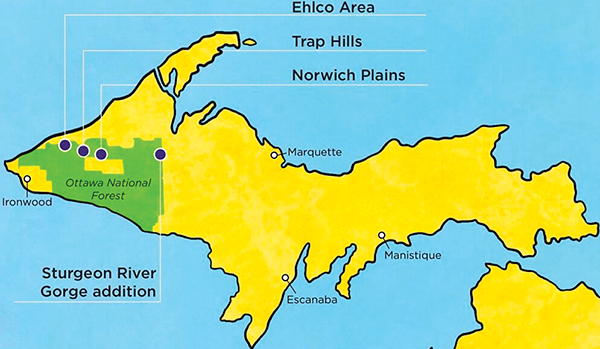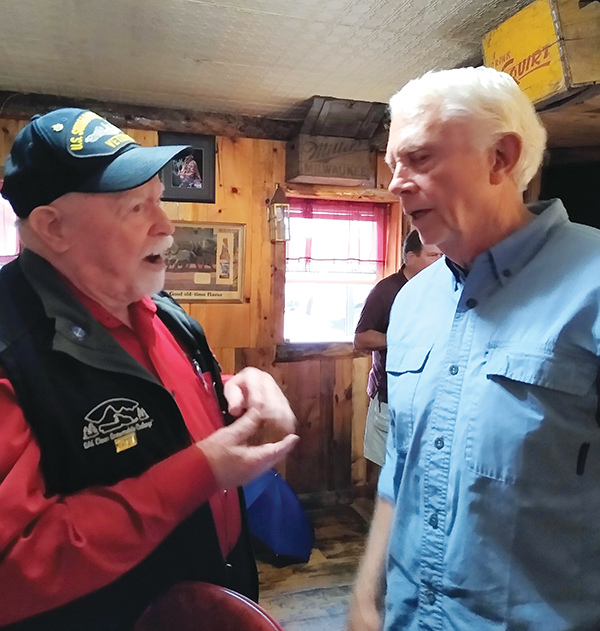By Jim Duke
Recently there’s been an alarming concern within the motorized recreation community about the aggressiveness of environmental groups to convince Congress to approve more areas for the designation of Wilderness. The primary organization behind this movement is the Wilderness Society whose goal is, and always has been, the 30X30 initiative recently picked up by the Biden administration and publicized as part of the President’s plan to stem, or eliminate, the effects of climate change.
While I can understand the desire to preserve our natural resources, I question the motives behind the recent push to add more Wilderness areas to our great state. For the many folks who are still uninformed to this action, let me enlighten you just a bit and point out a few little-known facts as well. The push I refer to is the latest attempt by environmentalists to reduce, or effectively eliminate motorized and mechanized access to several thousand acres of pristine public lands in the Upper Peninsula, known as the Ottawa National Forest, although that will never be made public in their agenda, nor will they ever admit to it. Some folks I’ve recently discussed this with believe it is simply an opportunity provided by President Biden’s thirty by thirty plan, already mentioned.
In a statement by the President of the Upper Peninsula Environmental Coalition, their recent efforts to add four more areas under the Wilderness Act of 1964 is to prevent desecration of the lands by logging and mining interests and keep the areas as undisturbed as possible. Our opposing view believes by creating more wilderness areas it is actually taking away jobs and meaningful employment opportunities for local inhabitants, which both the timber and mining industries in the affected areas provide, not to mention a major loss of revenue from the recreational sector.
A Little Wilderness History
A couple of hundred years ago the two main industries in the Upper Peninsula were logging and mining, The majority of mines were looking for copper which, by the way, was so plentiful, the U P became known as Michigan’s “Copper Country”, a name that has stuck with us to this day, but primarily in the Keweenaw.
As for logging, the lush U P forests provided an abundance of timber and was, in many cases, recklessly logged off in keeping with consumer demand. But this was several decades ago and before there were stringent guidelines to regulate such activities, and yes, there are several areas remaining today in witness of loggers razing the lands. The Upper Peninsula is dotted with settlements, many now uninhabited, from days of the “mining & logging hay-days” of the 1800’s.

When it became evident of what was happening to the land due to such ravages, Congress stepped in and took measures to stem the devastation by declaring many areas “off-limits” to loggers and miners, even though some of the areas had already fallen victim to the mining shovels or the cross-cut saws of the timbermen and designated such areas as Wilderness.
To ensure compliance with these new rules, several land management agencies were established including the U.S. Forest Service, the National Park Service, the Bureau of Land management, and the U.S. Fish & Wildlife Service.
It wasn’t long before designating large tracts of public lands Wilderness became a popular tool for the politicians use in their re-election campaigns, and in some cases was the only reason they remained in office. Designation of Wilderness of any area today requires the approval, and an official act of Congress.
Looking at Current Wilderness Statistics
To date, more than eight hundred areas across the country has been designated Wilderness, totaling about one hundred twelve million acres of federal lands, and spread out over forty-four states. The reasons for the Wilderness designation varies from locale to locale, from protection of hallowed grounds and/or endangered species, to preservation of pristine forests and grasslands. Our great state of Michigan is one of the states where sixteen Wilderness areas dominate the landscapes, with thirteen of them in the Upper Peninsula.
Unless interested parties do diligent research on the subject, they may think the efforts of the environmentalist groups are in the best interests of the citizenry and support those efforts without realizing the true intent of their veiled agenda. In almost every conversation with members of these so-called environmental groups, they will claim that their only concern is for the betterment of humanity, protection of wildlife, and saving the planet for future generations. Their true intent, however, is simply to eliminate any kind of encroachment on to any public lands and waterways other than by foot or paddle.
The timber industry throughout the state still flourishes today, thanks in part to the sustainable forest plans put in place by both the National Forest Service and the State Department of natural Resources and adhered to by every contractor seeking to conduct logging operations on any public lands. As for the new mining interests, there has always been and probably always will be opposing sides to the development of any new areas. In fact, those folks claiming common side effects such as air and water pollution will create health hazards have no real data to prove it but will nevertheless continue to preach it as long as they can find an audience.
As disconcerting at that may be, the major concern from the recreational aspect is the elimination of access to these areas should they eventually by designated as Wilderness, or even considered for it by Congress. There are hundreds of miles of trails and two-track forest roads within the four proposed areas currently open to motorized use, and several have been designated as snowmobile and/or ORV trails with clubs and volunteer organizations maintaining them in a safe and usable condition.
The Coalition’s claim that a wilderness designation would improve their ability to attract tourists and thereby increase revenue is simply not true, just the opposite! It will cause a shortfall in revenue because those who visit the areas annually to recreate will no longer have access and thereby go to other destinations.
Their only comparison for an increase in visitations is the Sleeping Bear Dunes where the number of visitors was up shortly after it received a Wilderness designation, but that particular area wasn’t much of a draw for snowmobilers and only a few other motorized users anyway.
The four proposed areas are all located within the Ottawa National Forest and encompass almost sixty-thousand acres with more than forty thousand in Ontonagon County alone and about another twenty thousand in Houghton County. For those familiar with the western U P and the Ottawa, the four areas are known as the Trap Hills, the Ehlco Area, the Norwich Plains, and the Sturgeon River Gorge. Most know this last one is already designated Wilderness, but the proposal is to increase the buffer by another two thousand acres.
What many do not know is that three wilderness areas already exist in the Ottawa National Forest, the McCormick and the already mentioned Sturgeon River Gorge located near Kenton and the Sylvania near Watersmeet. These three areas combined encompass more than nine hundred nineth-three thousand acres, so if the four new areas are accepted, approved, and designated, more than a million acres of pristine forest land will be off-limits to all except those who can ably walk in… no motors, no battery-operated wheelchairs, only human power.

That’s right, once designated all motorized activities would be prohibited, meaning visitors will no longer be able to drive their vehicles to the several isolated attractions which are currently available to tourists and visitors. For the snowmobilers and other trail users, it will create an interruption in the continuity of designated trails and the ability to travel from one destination to another, and for those employed in businesses that provide services such as food, fuel, lodging, and evening entertainment, it will mean less revenue and consequently, less wages and tips.
The average snowmobile trip is three to five days duration with each participant spending approximately $150 – $200 per day. During the winter months most snowmobile trail counters show between 3000 and 5000 riders daily with the more popular trails seeing upwards of 7000 to 8000 thousand or more per day. This is the economic input to communities that will be lost.
The myth that motorized recreationalists don’t care about the environment couldn’t be further from the truth, and the organized clubs and associations work tirelessly to make sure that both private and public lands open to their use remain in a safe and stable condition. Many clubs participate in Arbor Day and Earth Day activities by planting trees and beautification of areas within their own locales and assist with many other community efforts as well.
Yes, everyone agrees that preservation of our forests and wetlands is of primary importance, not only for tourism but for our basic existence as well, but we must not “cut off our nose to spite our face” in the name of protecting the planet. We need to have the ability to legally hunt, fish, and recreate on the lands at our disposal. To prohibit any of these endeavors by declaring the lands off-limits will serve no good purpose and a wilderness designation will do just that!
The Upper Peninsula is truly a beautiful and inviting place where everyone that has ever visited wants to return. Our pristine forests are home to countless specie of wildlife and our many rivers and lakes hold enough fish to feed a nation. These resources are what makes the U P so unique and inviting, creating more wilderness areas will only diminish the attractiveness. Thirteen of the sixteen already designated wilderness areas within the state is more than enough… This is an opposing view from the many folks who will be impacted by more unnecessary regulation. •

